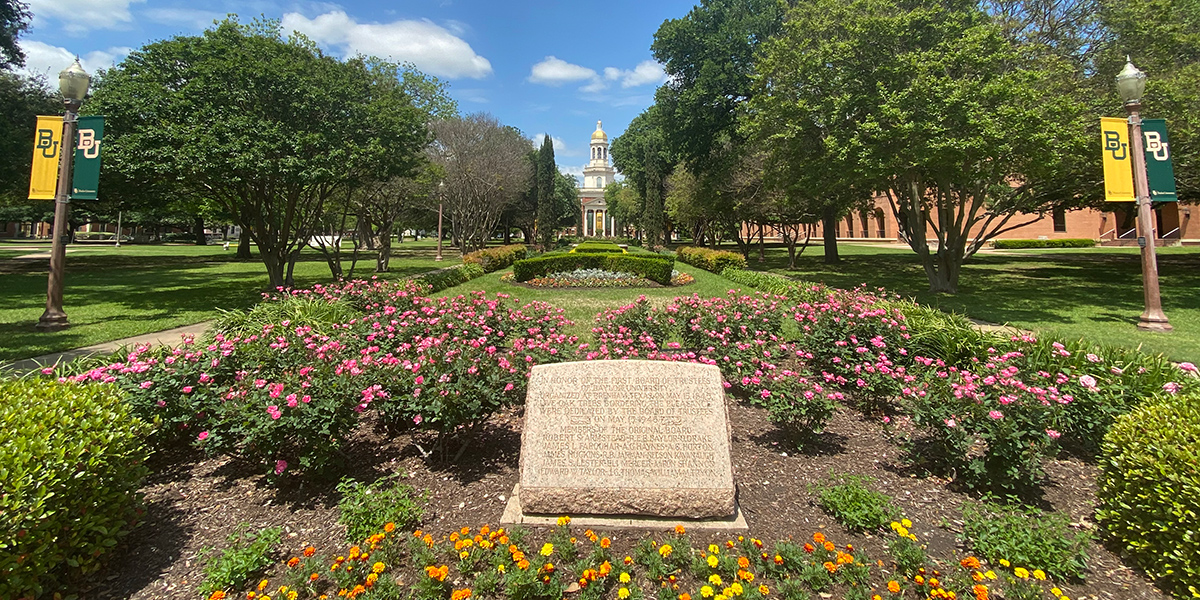10 things we’ve learned about slavery/racism & Baylor’s history from the Conversation Series

Last summer, Baylor’s Board of Regents established a Commission on Historic Campus Representations to review the history of the university, its founders, and its early leaders for connections to slavery and the Confederacy. The Commission spent the next six months looking at Baylor’s history and developing a series of recommendations on how the university can best address its past, particularly regarding campus statues, buildings and other features.
Baylor Regents spent the early months of 2021 reviewing the Commission’s work, and university leadership decided to hold a series of Conversation Series events that would publicly lay the groundwork for the report’s release. (That’s what universities do, after all — seek new knowledge, and then follow where the information leads.) The three-part series, moderated by Baylor history’s Dr. Ronald Johnson and President Linda Livingstone, brought in academic experts as well as the Commission’s co-chairs to discuss “Slavery in America,” “Slavery in Texas and Baptist Life,” and “Baylor’s Founding and the Commission’s Work.”
If you haven’t yet had a chance to watch these sessions, they are excellent and absolutely worth your time. To whet your appetite, here’s a sampling of the conversations — 10 things our BaylorProud team learned about slavery, racism, and Baylor’s history:
1. The British came to the Americas pledging liberty, and tried multiple labor systems (indentured servitude, convict lease, etc.) before settling on slave labor as the most profitable approach. By the 17th century, British laws had been reinterpreted to note that a change in religious status (salvation/baptism) would not equal a change in civil status (citizenship); freedom in the Lord was not the same thing as freedom under the law. Thus, the freedom fought for by white leaders during the American Revolution was widely understood as having little to do with the rights of enslaved people.
2. From 1492 until about 1820, of the millions of people who crossed the Atlantic to America, roughly two-thirds were Africans — and the vast majority of those were enslaved peoples.
3. Slavery played an important part in Texas’ growth in the 18th and 19th centuries. When land grants were made in early Texas, for instance, additional land was granted based on how many enslaved people a man brought with him. And when Mexico abolished slavery in 1829 — seven years before Texas fought for its independence — white Texans negotiated an exemption. After Texas independence, Britain (which had abolished slavery in 1833) diplomatically urged the Republic of Texas to abolish slavery, but the young nation spurned the suggestion (in part to gain favor with the United States).
4. The Underground Railroad that facilitated escape for enslaved individuals in some parts of the country didn’t work the same way in Texas. Philadelphia and other northern havens were too far away, and there was no defined network to help those who escaped. What little help they found more likely came from Tejanos or Mexicans than from white Texans.
5. The vast majority of enslavers in the South were essentially evangelical Christians. In the 15th century, European Christians had begun to use “the curse of Ham” referred to in Genesis 9 as a reason to justify enslaving Black Africans. A South Carolina Baptist pastor argued in 1822 that if the Apostles had believed slavery to be wrong, they would not have tolerated it — therefore, abolitionism was unbiblical. Any debate over whether slavery was Biblical tended to focus on whether it was allowed in Scripture, rather than if the way enslaved people were treated was just.
6. Despite the denomination’s reputation for dissidence, few (if any) Texas Baptists spoke against slavery leading up to the Civil War. In fact, the Southern Baptist Convention was founded in 1845 largely as a reaction to a national Baptist convention’s refusal to approve the appointment of a Georgia slaveholder as a Baptist missionary.
7. Many early Texas Baptist leaders owned enslaved persons and/or held the racist views common at that time. This included Baylor’s three founders — Judge R.E.B. Baylor, Rev. James Huckins and Rev. William Tryon — as well as most early Baylor Board members and many other early BU leaders. (A generation later, Baylor’s campus in Independence served as a barracks and training ground for the Confederacy, and the vast majority of administrators, faculty and students at that time supported the Confederacy.)
8. Baylor was far from the only university whose founders and early leaders had extensive ties to slavery. Thomas Jefferson’s role in founding the University of Virginia and his ownership of slaves are both well-known. The plantation home of ardent slavery proponent John C. Calhoun still sits at the heart of the Clemson campus. Baylor is not even the only Baptist-founded school with such ties; Wake Forest, Furman, Mercer, and Southern Baptist Theological Seminary, to name a few, have all had to deal with their history in recent years.
9. Baylor University did not own slaves (as did some other institutions at this time), but the foundational wealth the university was built on, particularly in and around Independence, was largely the result of the cotton, or slave, economy that was in Washington County with the fertile land along the Brazos River basin.
10. Many Confederate monuments went up across the South in the early 20th century, decades after the Civil War — even in states like Arizona, which were not part of the Confederacy. These monuments effectively served as reminders to Black Americans about their place in society and that white people did not see them as equals. (Even today, there are exponentially more monuments and statues to Confederate heroes across the South than there are for abolitionist heroes nationwide.)
As one panelist, Rice University’s Dr. James Sidbury, put it, “These are not problems that any of us created, but they are problems that are the responsibility of all of us to try to address. They’re the world we were born into, and slavery is so central to that, and it’s not nearly as far in the past as we would like to think… You don’t really love your country if you only love it by denying what happened… To have legitimate pride, it must encompass the things that are not perfect. And that’s a difficult thing.”
The same holds true at Baylor: We don’t love our university by ignoring what happened, but by coming to grips with all of it — the good and the bad. Another panelist, Baylor College of Medicine’s Dr. Alicia Monroe (a BU Regent), referred to the up-and-down stories of such Bible heroes as David and Jacob, noting that “If Scripture can be authentic, then Christians at a Christian university that aspires to fulfill a Christian mission can do the same.”
[Before continuing — A hearty “sic ’em” of thanks to the panelists and Commission members who gave so freely of their time to help us work through Baylor’s past so we can navigate the future together. As Commission co-chair Walter Abercrombie (BSED ’86, MSED ’92) noted, “I began to wonder, ‘How can I feel good about my university when I know there’s this past?’ … I found a place of peace, but a determination to make sure that we educate and that we move forward in a positive way together, as an American society and as a Baylor Family.”]
The Commission’s report (including recommendations) will be released next Tuesday, March 23. Those involved have repeatedly stated that the goal is not to erase history; rather, Baylor leadership is coming at this issue from an “additive” approach, aiming to tell a more complete history of the university. That could mean adding campus displays honoring some Black campus pioneers, adding signage to existing campus monuments and buildings, or other actions that help contextualize important historical figures and their contributions — moves designed not to erase history, but to remember it more fully.
Between now and then, I strongly encourage you to watch as much of the Conversation Series events as you can; they are available in their entirety at the links above and on Baylor’s YouTube channel (which makes viewing easy on a Roku, Apple TV or similar device). They say those who forget the past are doomed to repeat it, so instead, let’s engage our past, that we might build a brighter future for Baylor and all the students who will walk its campus in the years to come.
Sic ’em, Bears!

